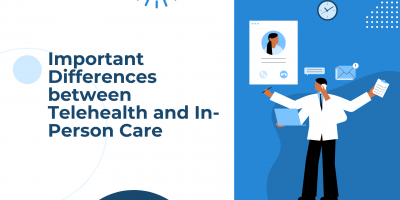
Important Differences between Telehealth and In-Person Care
Telehealth, which surged in use during the pandemic, has now established itself as a permanent fixture in healthcare. But how does it fare against in-person care?

With an aging population and a global workforce that works longer before retiring, the incidence of cancer in the workplace will increase.
Early cancer diagnostic services and improved treatments mean survival rates are higher than ever, and many cancer patients resume their normal daily activities, including work.
However, many employees facing a cancer diagnosis may not know that cancer is a disability under the Americans with Disabilities Act (ADA). This means they are legally entitled to specific accommodations from their employer, such as flexible work hours, modified job duties, or additional breaks.
Cancer patients need to be aware of their rights under the ADA so that they can advocate for the accommodations they need to succeed in the workplace.
In 1990, the Americans with Disabilities Act (ADA) was enacted, marking a significant milestone in civil rights.
The ADA is designed to end discrimination against individuals with disabilities in virtually every aspect of public life. That means it covers everything from employment and education to transportation and even extends to all public and private spaces accessible to the general public.
The United States Department of Justice upholds ADA requirements across three key domains:
Title IV pertains to individuals with hearing and speech impairments and is overseen by the Federal Communications Commission (FCC).
The ADA prohibits discrimination against employees with disabilities in all aspects of employment, including hiring, firing, pay, job assignments, promotions, layoffs, training, and fringe benefits. The EEOC (Equal Employment Opportunities Commission) oversees the employment provisions of the Americans with Disabilities Act (ADA).
Ultimately, the main goal of the ADA is to ensure that people with disabilities have the same rights and opportunities as everyone else.

The Americans with Disabilities Act (ADA) offers a comprehensive framework for defining disabilities, including those associated with cancer.
The ADA defines a disability as “a physical or mental impairment that substantially limits one or more major life activities, a record of such an impairment, or being regarded as having such an impairment.”
Major life activities covered by the ADA encompass a broad spectrum, including but not limited to:
When discussing cancer, it’s essential to recognize it is a severe disease that can significantly affect a person’s physical well-being and mental health. Cancer treatment can also be debilitating, and patients may experience many symptoms and side effects.
Despite this, cancer was not always considered a disability under the Americans with Disabilities Act (ADA).
However, the ADA has been amended to include broader cancer-related conditions as disabilities, ensuring that people with cancer have the same rights and protections as other people with disabilities.
Cancer is a complex group of diseases characterized by the uncontrolled growth and spread of abnormal cells, posing a serious threat to health and, in many cases, leading to fatal outcomes if left untreated.
The impact of cancer on an individual’s life is multifaceted and depends on several variables. These variables include the cancer’s primary site, its stage of progression, the person’s age and overall health, and the specific treatments administered.
In addition to its physical and emotional challenges, cancer can have lasting effects that may impact the ability to work and perform daily tasks.
Over half of all men and a third of all women will be diagnosed with cancer during their lifetimes, according to the National Cancer Institute (NCI).
This means that many of us know someone who has dealt with this disease, and we are no strangers to its challenges.
Cancer often causes a range of physical challenges, such as pain, fatigue, and diminished physical capabilities. These symptoms can vary widely depending on the type and stage of cancer. Commonly reported side effects include nausea and vomiting, hair loss, weight loss, depression, cognitive difficulties, and respiratory challenges.
On top of that, the emotional toll of a cancer diagnosis and treatment cannot be underestimated.
Anxiety, depression, and the stress of managing a life-altering illness can significantly impact an employee’s well-being. Cancer not only affects the diagnosed person but also substantially impacts their whole social circle, including caregivers, colleagues, and family members.
Moreover, managing medical expenses, cancer insurance claims, and potential loss of income due to extended leave or reduced work hours can create financial stress for the employee.
This financial burden can further impact their ability to focus on work and daily tasks.
While some employees successfully overcome cancer and resume their regular lives, many continue to grapple with lasting, sometimes permanent, repercussions from their treatments.
These repercussions, often called “late effects,” are side effects of cancer treatment that manifest after the treatment has concluded. Many cancer survivors might encounter these late effects years following their treatment.
In other words, the very treatments that may have saved lives can also cause ongoing side effects. These can encompass physical disabilities resulting from surgery, radiation, or chemotherapy and ongoing health challenges or complications.
Commonly recognized effects include infertility, nerve damage that may prevent activities like driving, heart problems, and dental and vision issues.
Moreover, the psychological trauma associated with a cancer diagnosis can persist long after treatment wraps up.
Patients in remission often undergo frequent tests, which can trigger what’s commonly called “scanxiety.” For those who’ve faced a cancer diagnosis, undergoing imaging scans can evoke a rollercoaster of emotions.
According to the National Behavioral Health Network, approximately half of cancer survivors struggle with some degree of anxiety, with some individuals experiencing it to the extent of being diagnosed with post-traumatic stress disorder (PTSD).

Work can provide a sense of normalcy and financial support for employees with cancer.
However, the physical and emotional effects of cancer, as well as the side effects of treatment, can make it difficult to maintain a normal work schedule and productivity.
Even essential job functions like walking, lifting, and socializing may become challenging. Additionally, some cancer patients experience treatment-related cognitive impairments, such as “chemobrain.”
Chemobrain can significantly impact employees’ ability to work and perform daily tasks. For example, an employee with chemobrain may have difficulty remembering instructions, meeting deadlines, or completing complex tasks. They may also have trouble multitasking or working in a fast-paced environment.
Employees with cancer may require adjustments to their workload or job tasks to accommodate their abilities during treatment and recovery. Flexible work hours, reduced workload, modified responsibilities, or the ability to work remotely may be necessary to support their productivity.
Clearly, the effects of cancer and cancer treatment on a person can range from mildly debilitating to severely incapacitating.
But would that qualify them as disabled? And is cancer considered a disability under the ADA?
Whether cancer is considered a disability under the ADA depends on how it affects a person’s ability to engage in essential life activities, such as eating, driving, or working.
If cancer significantly limits one or more major life activities, it is likely to be considered a disability under the ADA. This applies to individuals currently undergoing cancer treatment or experiencing long-term side effects from cancer or its treatment.
The United States Equal Employment Opportunities Commission (EEOC) clarifies that cancer isn’t always automatically classified as a disability.
The ADA can provide protection when cancer impedes or makes it extremely difficult to perform everyday tasks like household chores, bathing, or getting dressed. However, this disability must be either permanent or long-term.
On January 1, 2009, the ADA Amendments Act of 2008 changed how the ADA’s definition of disability was interpreted.
While the original definition of disability covered impairments of “major life activities”, now it also includes “major bodily functions.”
These amendments extended coverage to a broader range of physical and mental disabilities, encompassing functions related to the immune system, cell growth, digestive, bowel, bladder, brain and nervous system, respiratory, circulatory, endocrine, and reproductive systems.
These changes made it easier for many people with cancer to meet the ADA’s definition of disability.
Due to the amendments made by the ADA Amendments Act, individuals with cancer, whether currently active or in remission, should typically qualify as having a disability under the ADA.
Similarly, those with a history of cancer are covered under the ADA because they have a record of an impairment that substantially limited a major life activity in the past.

Certain employees with cancer may require leave for medical appointments or recovery.
The ADA mandates that employers provide reasonable accommodations, such as adjustments or modifications, to ensure equal employment opportunities for job applicants and employees with disabilities.
This should be done unless it poses an undue hardship, such as significant difficulty or expense. These accommodations may be necessary due to the limitations caused by cancer itself, the side effects of treatment, or both.
Additionally, the ADA obligates employers to consider providing unpaid leave as a reasonable accommodation if needed by an employee with a disability, as long as it doesn’t create undue hardship for the employer. This applies even if:
Here are some examples of reasonable accommodations that may be provided to people with cancer:
It’s important to note that the ADA applies to employers with at least 15 employees. However, employees working for smaller companies may still be protected against discrimination through state-fair employment laws that mirror the ADA’s provisions.
In the United States, federal laws and regulations protect employees’ right to work and to be treated fairly at work, even if they have cancer. Employees must disclose their cancer diagnosis to benefit from these legal provisions. Some safeguards to protect employees include:
Unfortunately, despite legal protections, people with cancer can still encounter obstacles to equal job opportunities.
Discrimination often arises from misperceptions among supervisors and co-workers regarding a cancer patient’s ability to work during and after treatment.
Even with a favorable prognosis, some employers may assume that a cancer diagnosis will lead to long work absences or hinder job performance.
Discrimination can manifest in various ways:
For instance, demanding that all employees in a role involving prolonged standing, while an employee with cancer finds it challenging due to their condition, may constitute indirect discrimination.
As an employer, it is crucial to understand your responsibilities in preventing workplace discrimination and implementing policies that ensure that employees dealing with cancer and their caregivers are not disadvantaged during recruitment, while working, or upon returning to work.
While many organizations are starting to address cancer by integrating it into their health and well-being strategies, there’s room for improvement.
Where can companies make improvements?
Many of these efforts mainly focus on a preventative approach, such as regular screenings and promoting healthy lifestyles.
However, employers should also establish guidelines that support employees impacted by cancer and reintegrate cancer survivors into the workplace.
According to one survey, nearly three out of ten respondents (29%) either agree or strongly agree with the notion that “companies inadequately support employees with severe illnesses.”
When asked about areas where their organizations could enhance their practices and policies concerning employees with cancer, survey participants are most inclined to mention the need for managerial training to effectively handle subordinates facing illness.
For these reasons, companies should have clearer information about their guidelines and policies regarding severe and chronic illnesses in the workplace, and promote awareness of resources that could help employees, like pain management resources and employee assistance programs.
In conclusion, it is essential for cancer patients and survivors to be aware of their rights under the Americans with Disabilities Act (ADA). Cancer is considered a disability under the ADA, and individuals currently undergoing treatment or experiencing long-term side effects are protected by this legislation.
Returning to work after a cancer diagnosis can be challenging, but with proper support, understanding, and adherence to legal protections, employers and employees can navigate this process more smoothly. It is crucial to recognize that addressing the needs of cancer patients and survivors has far-reaching implications for society, the labor market, organizations, individuals, and their overall well-being.
For further guidance and resources on this topic, individuals and employers can explore organizations and support networks specializing in cancer and disability rights and consult with legal professionals knowledgeable about ADA compliance and workplace accommodations.
Disclosure: The information provided in this post is for general informational purposes only and should not be considered as legal or medical advice. For advice on specific issues, please consult with a qualified professional.
Senior Content Writer at Shortlister
Browse our curated list of vendors to find the best solution for your needs.
Subscribe to our newsletter for the latest trends, expert tips, and workplace insights!

Telehealth, which surged in use during the pandemic, has now established itself as a permanent fixture in healthcare. But how does it fare against in-person care?

Despite the progress, women have unique health needs beyond reproductive and maternal care, and not all of them are met.

Projections suggest that diabetes could affect one out of every three Americans by 2050. Can diabetes programs help?
To what extent do breast cancer patients struggle with financial toxicity while battling this illness? What factors contribute to this financial toxicity?
Used by most of the top employee benefits consultants in the US, Shortlister is where you can find, research and select HR and benefits vendors for your clients.
Shortlister helps you reach your ideal prospects. Claim your free account to control your message and receive employer, consultant and health plan leads.